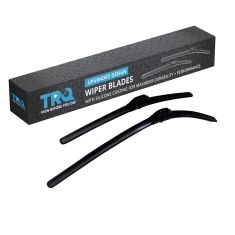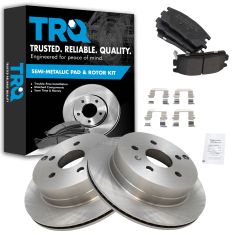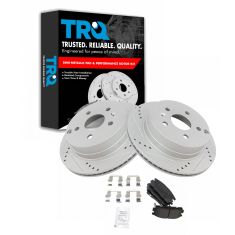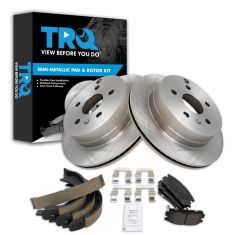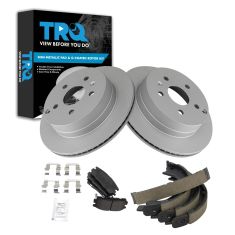Replaces
2010 Chevrolet Equinox Rear Semi-Metallic Brake Pads TRQ BFA73712
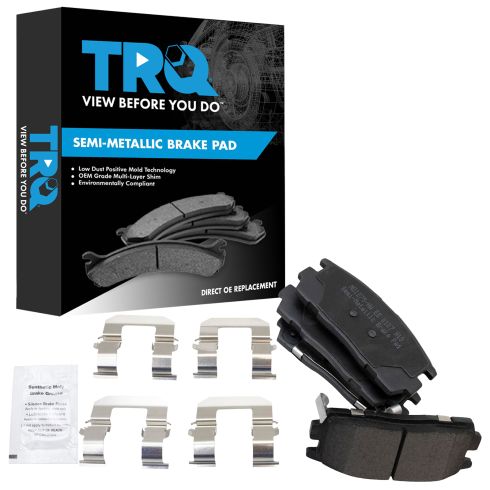

BFA73712
This part doesn’t fit a . Select from parts that fit.
Specify your vehicle's year, make and model to guarantee fit.
This part does not fit a .
Buy in the next and
Get it by: Wednesday, Dec 17 with expedited shipping
Recommended for your 2010 Chevrolet Equinox
Get the kit
Part Details
- 0.55 in
- 14 mm
- 8 mm
- 0.31 in
- Yes
- Integrally Molded
- Yes
- No
- Yes
- 4.37 in
- 111 mm
- Contact Point Grease
- Hardware
- 1.81 in
- 46 mm
- No
- 4
- N
- Premium Posi
- Semi-Metallic
- Semi-metallic
- Mechanical
- Black
- Black
- 8 mm
- 0.31 in
- Yes
- Yes
- 1.81 in
- 46 mm
- Yes
- Yes
- 0.55 in
- 14 mm
- 4.37 in
- 111 mm
- Fiber
- Steel
- No
- Yes
Specifications
- Rear
About TRQ:
TRQ is a trusted brand dedicated to making every repair a success story by combining premium parts with easy installation. Each TRQ part is engineered by a team of automotive experts to meet or exceed OEM standards, delivering enhanced performance and maximum longevity. With rigorous in-house testing, the brand ensures superior fit and function across every product line. TRQ also provides customers with best-in-class, step-by-step installation videos—so you can complete repairs with confidence, whether you're a first-time DIYer or an industry professional.
Product Features
TRQ brake pads are manufactured using premium raw materials and design standards to restore original performance. TRQ brake pads are positive molded and utilize a multi-layer shim for enhanced performance and service life. TRQ’s combination of materials and design ensures a low dust and low noise braking experience. TRQ recommends replacing your brake rotors when you replace your brake pads to ensure even wear of components and improved braking comfort. All products are fit and road-tested in our Massachusetts R&D facility to ensure we deliver on our promise of Trusted Reliable Quality.
Attention California Customers:
![]() WARNING: This product can expose you to chemicals including Lead and Lead Compounds, which are known to the State of California to cause cancer, and birth defects or other reproductive harm. For more information, go to www.P65Warnings.ca.gov.
WARNING: This product can expose you to chemicals including Lead and Lead Compounds, which are known to the State of California to cause cancer, and birth defects or other reproductive harm. For more information, go to www.P65Warnings.ca.gov.
Lifetime Warranty
This item is backed by our limited lifetime warranty. In the event that this item should fail due to manufacturing defects during intended use, we will replace the part free of charge. This warranty covers the cost of the part only.
FREE Shipping is standard on orders shipped to the lower 48 States (Contiguous United States). Standard shipping charges apply to Hawaii and Alaska.
Shipping is not available to a P.O. Box, APO/FPO/DPO addresses, US Territories, or Canada for this item.
Expedited is available on checkout to the United States, excluding Alaska, Hawaii.
Final shipping costs are available at checkout.



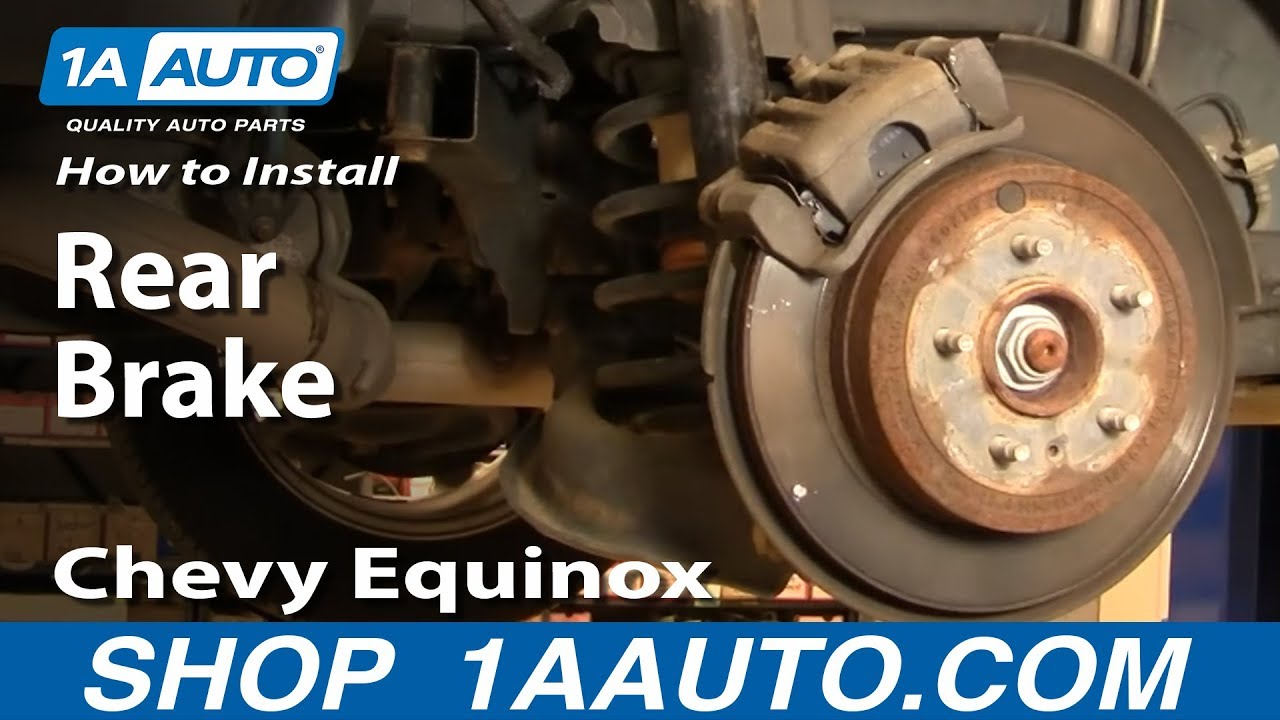
Created on:
Tools used
- Loosen the lug nuts with the vehicle on the ground Raise the vehicle with a floor jack Secure the vehicle on jack stands Remove the lug nuts Pull of the wheel If the wheel will not come off, thread the lug nuts on and strike the tire with a hammer
- Check the thickness of the brake pads Check for gauges on both sides of the rotor
- Remove the two 14mm bolts from the brake caliper Pull the caliper aside Pry the brake pads off with a flat blade screwdriver Remove the brake pad slides Clean the slides with a wire brush Apply anti-seize fluid or white grease to the slides Push the slides on with a flat blade screwdriver If only changing the pads, continue to Step 6 and install the new pads
- Remove two 15mm bolts from the brake caliper bracket Pull off the brake caliper bracket Remove the T30 Torx screw from the rotor Pull the rotor off If the rotor will not come off, thread the lug nuts and strike the hub area of the rotor with the ball end of a ball peen hammer
- Slide the rotor on Adjust the emergency brake, if necessary Put the bracket back into place, start the 15mm bolts by hand Tighten the 15mm bolts to between 75 and 80 foot-pounds of torque
- Put an old pad in the caliper Use a large C-clamp and the old pad to push the pistons back Install the new brake pads into the bracket with the wear indicator on the lower side Put the caliper on Thread the 14mm bolts by hand Tighten the 14mm bolts to between 20-22 foot-pounds If you replaced the rotor, reinstall the T30 Torx bolt Clean the rotor with brake parts cleaner or mineral spirits
- Slide the wheel into place Start the lug nuts by hand Tighten the lug nuts preliminarily Lower the vehicle to the ground Tighten the lug nuts to 100 foot-pounds in a crossing or star pattern
- Pump your brakes repeatedly until they feel firm Test your brakes at 5 miles per hour and then 10 miles per hour Road test the vehicle
Brought to you by 1AAuto.com, your source for quality replacement parts and the best service on the Internet.
Hi, I'm Mike from 1A Auto. I hope this how-to video helps you out, and next time you need parts for your vehicle, think of 1AAuto.com. Thanks.
In this video, we're going to show you how to do a rear brake job on this 2008 Chevy Equinox. This is basically the same for any Equinox and the Pontiac Torrent of this generation. Tools you'll need are jack and jack stands; tire iron or 19-millimeter socket with a breaker bar to remove the lug nuts; a 5-pound sledgehammer . that's kind of optional; our vehicle had the aluminum wheels, and they were somewhat stuck on .; 14- and 15-millimeter wrenches; a T30 Torx driver socket with a ratchet, if you are planning on replacing the rotors; a ball-peen hammer, again, for replacing the rotors; wire brush; large C-clamp; and a torque wrench.
If you don't have the benefit of air tools, you'll want to loosen the lug nuts while your vehicle's still on the ground, then raise and support the vehicle. Remove the lug nuts and wheel and tire. I'm fast forward as I remove those lug nuts. Okay, now you saw that I tried to hit it. I did put a lug nut back on and tried kicking, seeing if that can break it free. Unfortunately, it doesn't. Kicking it like that usually works, but if it doesn't, make sure you have a couple lug nuts on a few turns, big hammer, and you want to make sure you hit the tire. You do not want to hit the rim at all. Couple good hits with that.
Now you can inspect the brakes. The pads are worn pretty low. These rotors are still pretty nice and smooth. Pretty low-mileage vehicle, so they're in good shape. For now, we're just going to replace the pads, but I will show you how to take the rotor off and put it back on.
For the pads, there are two bolts. You want to loosen this bolt and remove this bolt. Bolts are 14 millimeter, and they should come off with a relatively small wrench. For this top one, you either want to use a wrench or just have a small extension for your ratchet. It's always easy to put the wrench on, hook another wrench on there. Gives you a little more leverage. Nice and smooth. Pull out on this caliper a little bit, just loosens it up. Remove this bolt down here, and the caliper just flips right up like that. Just use a regular flat-blade screwdriver to pry these pads right out. What you want to do next is, there's just these little stainless steel slides, pull those off. Then use a wire brush and clean them up really well. As soon as my slide's all cleaned up, I just put a touch of anti-seize. You can use that or some white grease. Just push these back into place. It always helps to just take a screwdriver, and make sure you push these on nice and tight. If you were just changing the pads, you put the pads back on.
If you want to take this whole rotor off, get in behind again. There are two more bolts, one here and one up there. These are 15-millimeter bolts. I'm going to use the wrench method again, just pull nice and easy until they come loose. I'm just going to fast-forward here. All I'm doing is working that wrench and removing those 15-millimeter bolts. Take that whole assembly right off.
This is a T30 Torx screw right here. If it doesn't come right off, put your lug nuts back on just a few turns. You want to use the ball end of a ball-peen hammer. You don't want to contact the rotor face. You want to hit it in the hub area. Once you see it moving, it pulls right off. Obviously, reinstall the new one. Put it on, and if the emergency brake doesn't feel a little bit resistant, you can actually adjust the emergency brake here. That can also be reached here. You could also reach that adjuster by pulling out this plug and using a screwdriver to turn that adjuster. I'll put that back on. Now put our bracket back in place. Put these bolts back in place, and then move it around a little bit until you get the bolts started. Fast-forward again here as I work those wrenches. Like I said, you put that bracket down in place, push the bolts in, and then turn them clockwise to get them started. Then I'm just working with the wrenches to tighten them up preliminarily. These should be tightened up to 75 or 80 foot-pounds. Lock my wrenches together again. Get them nice and tight.
Now you want to force this piston here, back into the caliper. What I generally do is take one of the old pads, put it right in there, a big C-clamp. Then as I tighten the C-clamp, it pushes that piston back in. Next thing you want to check is these bolts should slide back in place very easily, so just make sure they do.
Take my new pads from 1A Auto. You want to put the wear indicator, and you want to make sure it's on the down side, on the inside. Put the pads in. Make sure they squeeze together. Now to put the caliper back down, we have to push in on that side. These bolts can go back on. These bolts should only be tightened to about 20 to 22 foot-pounds, which I generally just use a wrench like this, and get them tight. Pretty much just give them a good push with this small wrench. That's usually pretty close. You see that this actually started spinning on me. I don't quite have the right wrench, so I'm just going to use a pair of pliers, make sure that's nice and tight.
Last but not least, if you did take the rotor off and replace it, put this little Allen bolt back in. Put this Torx bolt back in. Use a little brake parts cleaner or some mineral spirits to clean off the surface of the rotors.
I'll speed it up here as I put the wheel and tire back on. First, thread the lug nuts on by hand. Then tighten them preliminarily with a wrench before you put the vehicle on the ground. Torque the lug nuts to 100 foot-pounds using a star pattern. Last but certainly not least, make sure you pump up your brake pedal. Get it a good, firm pedal, then do test stops from 5 and 10 miles an hour before road testing your vehicle.
We hope this helps you out. Brought to you by www.1AAuto.com, your source for quality replacement parts and the best service on the Internet. Please feel free to call us toll-free, 888-844-3393. We're the company that's here for you on the Internet and in person.
Tools used
- Loosen the lug nuts with the vehicle on the ground Raise the vehicle with a floor jack Secure the vehicle on jack stands Remove the lug nuts Pull off the wheel If the wheel is stuck, thread on one lug nut on a couple of threads Strike the rear of the tire with a rubber mallet Remove the placeholder lug nut Pull off the wheel
- Hold the wheel studs with a brake rotor Remove the T30 Torx screw from the brake rotor Remove the two 14mm bolts from the caliper bracket Pull the caliper off Put the caliper aside Pry the brake pads off with a flat blade screwdriver
- Remove the two 15mm bolts from the caliper bracket Pull off the brake caliper bracket Pry the rubber plug out of the brake rotor Put the rubber plug aside Loosen the emergency brake adjuster as needed Strike the drum surface of the rotor with a hammer to loosen the rotor Pull the rotor off Clean the hub surface with a wire brush
- Pry off the brake pad shims with a flat blade screwdriver Clean the brake pad shims with a wire brush Clean the caliper bracket with a wire brush Apply brake grease to the shim-mounting area of the caliper bracket Place the shim onto the caliper bracket Apply grease to the caliper shims Pull out the caliper slides Apply grease to the caliper slides Push the caliper slide into the caliper
- Apply grease to the hub surface Put the rotor onto the hub backwards Spray the rear of the hub with brake cleaner Pull off the brake rotor Slide the brake rotor on Spray the front of the rotor with brake cleaner Insert the T30 Torx bolt into the rotor Set the emergency brake adjuster with a flat blade screwdriver Push the rubber plug into the brake rotor Put the caliper bracket into place Insert the two 15mm bolts into the caliper bracket Tighten the two 15mm bolts to 89 foot-pounds of torque
- Put the brake pads into the caliper bracket Apply grease to the back of the brake pads Push back the caliper piston with grove lock pliers Put the brake caliper into place Insert the two 14mm bolts into the caliper Tighten the two 14mm bolts to 24 foot-pounds of torque
- Slide the wheel into place Start the lug nuts by hand Tighten the lug nuts preliminarily Lower the vehicle to the ground Tighten the lug nuts to 100 foot-pounds in a crossing or star pattern
Hi, I'm Mike from 1A Auto. We've been selling auto parts for over 30 years. We're dedicated to delivering quality auto parts, expert customer service, fast and free shipping, all backed by our 100% satisfaction guarantee. Visit us at 1AAuto.com, your trusted source for quality auto parts.
In this video, we're going to be working with our 2008 Chevy Equinox. We're going to show you how to remove and replace your rear brake pads and rotors. While we are doing this on the driver side, we always recommend you replace your brakes in pairs per axle, meaning that you do the rears together or the fronts together. If you like this video, please click subscribe. We have a ton more information on this and many other vehicles, and if you want these brakes for your car, you can follow the link down in the description over to 1AAuto.com. Here are the items you'll need for this repair.
Using the 19 millimeter socket and breaker bar, loosen all of your lug nuts about one turn. Raise and support your vehicle. We're using a lift to make it easier to show you what's going on, but this job could easily be done in your driveway or garage with a jack and jack stands.
Normally, you would remove all five of your lug nuts and remove the wheel and tire. However, we've been having a hard time getting these wheels off of the car, because they've been on there so long. So, we'll show you a trick to remove a tire when it's stuck on the hub. We'll remove four of the lug nuts and loosen the top one so it's hanging on by just a couple of threads. The best way to do this is using a dead blow hammer; however, a rubber mallet will work. You don't want to use a steel hammer, because you'll risk damaging the wheel. Go ahead and hit the wheel in as many places as you can reach with your hammer. That's why we leave that lug nut on a couple of threads, so when it pops loose, our wheel doesn't just go flying off. Now, you'll just hold your wheel. Remove that last lug nut, and remove your wheel and tire from the vehicle.
Now, you'll remove the T30 rotor screw. I'm doing this with a Torx socket and a little breaker bar. You may need to use a pry bar between two of the wheel studs to keep it from rotating when you break this screw loose. Sometimes they'll come out without, but usually you're going to have to counter-hold. Once you get it broken loose, it should spin right out nice and easy.
Using a 14 millimeter socket and ratchet, remove the two 14 millimeter bolts securing the caliper to the bracket. Now, sometimes these pins will spin when you go to loosen the bolt. If yours is spinning, it takes a really skinny wrench to get on there. If you don't have one, you can use a pair of pliers, or they're usually not under a lot of torque so you can just kind of hold them and remove the bolts by hand.
Remove the caliper. Normally, we would use a bungee cord or something like that to secure it. However, this is on a pretty short hose. You can set just set it on that control on it. If you want to be a little more secure, you can wrap one around there, a zip tie or some mechanics wire will do that just to be safe. Using a flat blade screwdriver, or a small pry bar, remove the pads from the caliper.
Using the 15 millimeter socket and ratchet, remove the two caliper bracket bolts securing it to the spindle. You do have to be careful, because you have your shock here, so you’re not going to be able to back that one all the way out with a socket and ratchet. If you can't get it out by hand at that point, you may have to switch over and use a wrench. It looks like what we can do here is when that bolt is backed all the way out, you can slide the caliper bracket out, and then you can push the bolt in to remove your ratchet. It looks like this 15 is not going to want to come out past that bolt, but we can pull it out far enough that it doesn't interfere here. So, we'll just leave it there.
Now, you're going to need to save this little rubber plug here, because these aren't included with new rotors most of the time. Just pop that out with a flat blade. We're going to check that our e-brake isn't dragging, and it's not. But if it were, you would spin it around and use this access hole to find the adjuster, which we'll show you when the rotor's off. Back that adjuster off, so the e-brake doesn't drag on the rotor.
Now, if you need to save your rotor because, you’re doing a wheel bearing or something else that requires you to remove this without needing to replace it, you'll want to hit this surface with a hammer being careful not to hit the lug studs. However, if you're actually doing a brake job, you can hit the surface of the rotor for some more leverage, knocking this off.
Using a steel wire brush and the proper safety equipment, like safety glasses and a dust mask, go ahead and scrap all this rust and corrosion off of the hub. You'll want to scrap this off of the surface as well as the hub center here, which is why our rotor was so stuck on.
Here we have our old rotor and brake pads that we removed from our vehicle and our new parts from 1AAuto.com. As you can see, our rotors are the exact same size. We have the drum and hat style here where the e-brake is internal, which is what this access hole is for here. We also have the same bolt pattern and the same little bevel there for our rotor screw. The pads are the exact same size and shape. You can see how badly worn our old ones were. They were just about to the point that they were going to be dragging metal. Over here, the backing shim was actually touching the rotor a little bit. You always want to replace your brake pads and rotors together, unless you have the ability to have your rotors machined down, though that isn't very common in most places. The reason that is, is because there's a deep groove in this rotor, which means that we weren't getting a full, smooth, contact patch, and that it was affecting our braking. Also, being down this thin can cause the rotor to warp more easily from heat, which creates a pulsation while braking. These new parts from 1A Auto are going to go in direct fit, just like our original equipment. We'll fix you up right.
Using a small flat blade screwdriver, carefully pry the shims off of your caliper carrier. Now, ours are still pretty smooth. They don't have a lot of rust build-up on them, so we can just clean these off and reuse them. We'll do the same thing on the place they ride here, on the caliper carrier as well. We'll do this using a wire brush. Be sure you have proper safety equipment on, like some safety glasses and a dust mask so you don't inhale all this harmful debris. Now, all of the dirt and debris is off. You don't have to get these perfectly clean. It's not really likely that you'll get them perfectly clean and looking good and new again. However, as long as you've got all the heavy build-up off, it'll allow the shims to ride in there nice and flat, which will allow your brake pads to move smooth and freely which is really all we're after. Once we've cleaned that off, we'll repeat this process on the shim. If these are really heavily rusted and corroded or cracked, breaking, missing pieces, or they aren't springy any more – you can see this is still moving nicely – then you're going to want to replace them. Ours don't look bad so we can just clean them up. Put some fresh grease on there, and they'll be just fine. We'll want to do this on the front and the back to make sure that everything sits and rides smoothly. Again, just like the carrier, as long as you get the bulk of the stuff off, they don't have to be perfect.
Now, we'll apply a thin coat of grease where our shims are going to ride. Make sure you're using brake specific grease for this. Anything else could get onto the pads and rotors and damage them. Brake grease is designed to be on these components, so it's a lot less harmful if something does happen. Re-install your shim. Then, we'll apply a thin coat of grease to that as well. You can go a little bit thicker here since this is where the pad is actually going to move. Nothing moves on this portion out here, but if you lay a little coat of grease on it's not going to get all rusted and corroded.
While we have the grease out, we'll hold back the boot here on our caliper pin. Remove that. Ours is pretty clean, but if you have a bunch of old gunk and grease buildup on there, you'll want to wipe it off with a paper towel. Apply a good thick coat of fresh grease. Re-install it into the boot. Make sure it suctions on there, and it moves nicely. Then, we'll repeat all of these steps on the other end of our carrier. Now, our caliper carrier's ready to go back on our vehicle.
Apply a thin coat of grease to the hub to make sure your rotor doesn't seize to it in the future, because brakes are a wear item. You may have to do them again some day. Install your rotor onto the hub backwards. Spray it down with some brake cleaner. This removes the coating they use when these are in storage, between the factory and being delivered to you. This prevents them from rusting. However, it is very slick and will affect your braking if you leave it on there. Now, we'll install it the correct way with the beveled hole over the threaded hole in our hub. Spray down this side as well.
Re-install the rotor screw with a T30 Torx bit. Now, it's not dangerous if you've lost this or broken it. All it really does is help keep this rotor in place and make it easier to re-assemble everything, but if you do have it, it's good to put back.
Now, we'll align the hole in the rotor with that adjuster wheel for the e-brake that we showed you earlier. We'll adjust it up by moving it a couple of teeth. Just wait to hear and feel that little bit of drag against the brake. Once that's all set, install the cap.
Re-install the caliper bracket and start your two bolts as far in as you can by hand. Then, finish tightening them down with a socket and ratchet. Torque the caliper bolts to 89 foot-pounds.
Install the brake pads. The little squealer was on the back side when we removed it, so, I'll put it back there, going back together. Apply another thin coat of grease to the back here. Remove whatever you used to secure your caliper. Use a pair of groove-job pliers to compress the piston. Be sure to go nice and slow here. Re-install the caliper and the two 14 millimeter caliper bolts. Torque your caliper bolts to 24 foot pounds. There's an example of that hinge spinning, so I'm going to hold it with a pair of pliers.
Re-install your wheel and tire. Get your 19 millimeter lug nuts on as tight as you can by hand. Put the weight of your vehicle back on the tires. Torque your lug nuts to 100 foot pounds in a cross pattern.
Thanks for watching. Visit us at 1AAuto.com for quality auto parts, fast and free shipping, and the best customer service in the industry.
Tools used
Hi. I'm Mike from 1A Auto. We've been selling auto parts for over 30 years.
Hi there. This is Sue from 1A Auto. Today we're going to do rear brakes on a 2012 Equinox. We're going to take a 22 millimeter socket and a breaker bar and we're going to break the lug nuts off the wheel. Now with your vehicle up in the air or supported with jack stands, you remove the lug nuts.
Now I'm going to break free the caliper from the caliper bracket by removing these caliper slider bolts. This is a 14 millimeter wrench. Now in this particular 2012 Equinox it has ABS in it. When dealing with ABS on a brake service, you have to push the piston back with the bleeder screw open to avoid any ABS module damage. This is a 10 millimeter wrench. I'm going to put it on the bleeder screw, give it a quick snap. There we go. I like to turn it just about a half a turn. We're all set there. Use a catch basin to catch your brake fluid. Screwdriver or pry bar, slide this caliper right up.
I use a pair of welders clamps that I like to put inside the piston and I just give it a slight squeeze, till that piston bottoms out. This also gives me a chance to do a quick visual on the caliper piston boot. I'm looking for any tears or leakage. If you were to find them, you would have to replace the caliper. And this also is a good way to test the caliper, to make sure that it's not a seized caliper piston. Once closed, I re-tighten the bleeder screw. Release the clamps.
On this Equinox we have no place to hang the caliper to put no strain on the flex hose, so we'll just set it aside, right there on that upper control. Now it's time to remove the caliper bracket from the knuckle. This is a 15 millimeter wrench.
I use a pry bar especially when the bracket is frozen a little on there. Work it back and forth. Now with our caliper bracket on our bench I'm going to hammer out the pads. Noting once again the indicator goes on the inside of the bracket. Set it in a special order. Now I'm going to clean up the caliper bracket and sliders.
Now we're going to remove the rear rotor. This Equinox 2012 has a little mounting bolt. It's a Torx head T30. Make sure you set it aside. It's going to get reused. When removing the rotor from the hub, I like to use a penetrating spray right around where the hub hat meets. Let that sit in for a little bit. Then we'll hammer it off.
Here on this 2012 Equinox we're going to compare the old to the new and what to look for. This is the outer pad and wear right down there, right past three millimeter, so that's probably right around 1/32 in, one millimeter. You can see the rust that forms on the hubs and the inner well on that ring. Here's your new product from 1A Auto, Nakamoto, nice clean fins cooling down, same size hub, same weight distribution. OE fit.
Quick note on these rear brakes. You're going to see a rubber boot on some manufacturers. That is an indicator window for the ebrake shoes, the emergency brake shoes right on the inside of this hat. So we're going to make sure we take the old one out and transfer it over. I use that with a small screwdriver or a pry bar. You pull it right out. I relocate it right away. That way I don't lose it. Just give it a little push down in. There it is.
First thing I like to do is take a wire brush to clean the surface rust off. Use a little brake and parts clean. Then I'm going to clean the caliper tin. You can also buy brand-new caliper tins and caliper slider boots on 1A Auto. That's if you don't feel like cleaning them. If it's not in the budget, let's just do it right. You want to clean all the rust off and any dirt so the pads have a nice sliding surface. Going to do the same thing to the other side.
Now I'm going to take the caliper slider boot out. Just basically you pinch down on the rubber slot boot and pull the slider out. That's old manufacturer grease so I'm going to clean that off. You always want to apply brake caliper grease, nice thin coat to the slider. I like to put caliper grease on the inside of the boot. That keeps it flexible and I also get to check for any holes. You don't want any pin holes or rips on these boots because then water will get into the pin and seize it up from sliding.
Before I put the caliper tin back on, I put a little bit of that caliper grease underneath. This assures it not to get rusty and swell up and push that pad on tight and freeze it on the bracket. You do not want to put any grease on the upside for it will collect road dirt in the pad, dust and stop that pad from sliding back and forth. Now I'm going to do the same thing to the other side.
While I have the brakes off of my 2012 Equinox, I'm going to give it a quick visual on the emergency brake shoes. We're looking for any chips. Sometimes the bonding comes unglued and the shoe actually comes off the metal backing. At that point they'd have to be replaced. But here we get great shape, so I'll just clean them down with some brake parts cleaner, get rid of the old brake dust that stores in there. I'm also going to give ... This hub is nice and clean, but I'm just going to give it a quick, quick wire brush, just to get any surface rust off. I like to apply a thin coat of anti-seize, especially around the hub where it meets the rotor. It'll stop any rust buildup in the future. Just needs a nice thin coat.
I'm going to put the rotor on backwards for a second. So that way I can have it held without bothering anyone and clean off the clear lubricant coat that they put on for packaging. Then I'll just spin it around and do the same on the other side. I'm going to line up the mounting hole with the screw hole.
Here I have my mounting screw, torx T30. Make sure I start it in straight, and then just going to snug it up once it reaches the bottom. Before I mount the caliper bracket on the knuckle, I'm going to clean the old thread lock off the threads and apply a light coat of new thread lock. Just a light little dab and it'll go through all the threads all the way around. Set that aside and do the same to the other.
Now we're going to install the rear caliper bracket on the rear brakes of this 2012 Equinox. Slide it right in there. Grab the mounting bolt. Start it by hand. The head of this bolt is a 15 millimeter. I'm just going to snug it because the torque for these caliper mounting bolts are 92 foot-pounds.
Now we're going to install the pads. The one with the indicator goes on the rear inner edge. Slides right in. Line the ears up. Drop it down in. There you go. Now I'm going to place the caliper down. Once we have already pushed that piston back, let's slide right over. Now we're going to install the caliper bolts on the sliders. The torque on these is 20 foot-pounds.
Now that we have the rear brakes all together, caliper mounted on this 2012 Equinox because we had open the bleeder screw to push the caliper piston back, we're just going to gravity bleed it. No need to touch the brake pedal at all. We're just going to watch, make sure fluid flows out, no air bubbles. See the little air bubbles forming at the top there. We just want those to naturally fall right out. Once it's snug, bottomed out, just give it a nice half a turn. Use brake parts cleaner to clean it up. Put the cap back on and we're ready to go.
Now we're ready to put the wheel back on, the rear of this 2012 Equinox. We're going to lower it down just like you would at home with the floor jack, just letting it touch the ground enough to tighten these to the torque specs, 140 foot-pounds, and then you lower the jack the rest of the way. Now we're going to torque the wheel lug nuts in a star sequence. Once your brake job is completed and you've topped off the brake fluid, it's always a great idea to pump your brake pedal up before you start the vehicle or try to drive it.
Thanks for watching. Visit us at 1aauto.com for quality auto parts, fast and free shipping, and the best customer service in the industry.
BFA73712
877-844-3393
Monday - Friday 8:00am - 9:30pm ET
Saturday - Sunday 8:00am - 4:30pm ET
Specify your vehicle's year, make and model to guarantee fit.
This part does not fit a .







